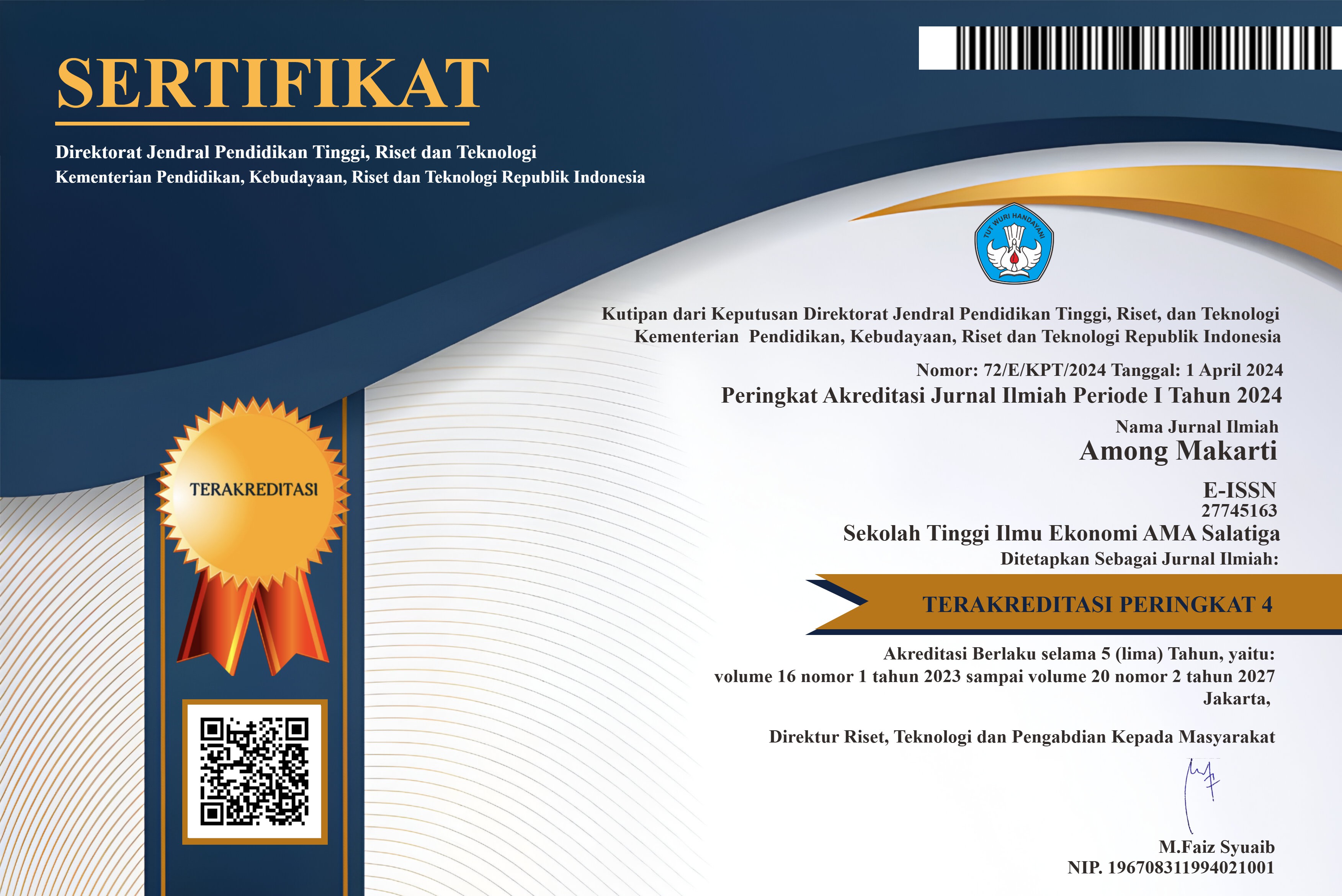PENGARUH IMPLEMENTASI PEMBAYARAN DIGITAL TERHADAP STABILITAS PERBANKAN DI INDONESIA (STUDI PADA BANK KONVENSIONAL DI INDONESIA YANG TERDAFTAR DI BURSA EFEK INDONESIA)
Abstrak
Abstract : This study focuses on how the stabilities of conventionals bank listed on the Indonesia Stocks Exchange (IDX) is impacted by digital payments. This study will also analyze how banks asset qualities and liquidity works as a control factors that may influence the relationship between digital payments and financial stability. Purposive sampling was used to generate a sample of 27 traditional banks. Instrument tests, descriptive analysis, t-tests, F-tests, classical assumption tests, and hypothesis testing with multiple regression analysis were all used to evaluate the data for this study. Based on the study, the stability of conventional banks in Indonesia is positively impacted by Z-Score, return on equity, and return on assets, with Non-Performing Loans and Loan to Deposit Ratio serving as control factors.
Abstrak : Fokus penelitian ini adalah bagaimana pembayaran digital memengaruhi stabilitas bank konvensional yang terdaftar di Bursa Efek Indonesia (BEI). Penelitian ini juga akan membahas bagaimana kualitas aset dan likuiditas perbankan berfungsi sebagai faktor kontrol yang dapat memengaruhi hubungan antara pembayaran digital dan stabilitas keuangan. Kumpulan 27 bank konvensional dihasilkan dari pengambilan sampel purposive. Untuk penelitian ini, data dianalisis melalui uji instrumen, analisis deskriptif, uji asumsi klasik, uji t, uji F, dan uji hipotesis dengan analisis regresi berganda. Dengan Non-Performing Loans dan Loan to Deposit Ratio sebagai variabel kontrol, penelitian menunjukkan bahwa ZScore, return on assets, dan return on equity menguntungkan stabilitas bank konvensional di Indonesia.
Kata Kunci
Teks Lengkap:
PDFReferensi
Albert, J. R., Song, L. L., & Schou-Zibell, L. (2010). A Macroprudential Framework for Monitoring and Examining Financial Soundness. SSRN Electronic Journal. https://doi.org/10.2139/ssrn.1587812
Aurazo, J., & Vega, M. (2021). Why people use digital payments: Evidence from micro data in Peru. Latin American Journal of Central Banking, 2(4), 100044. https://doi.org/10.1016/j.latcb.2021.100044
Bacchiocchi, A., Bischi, G. I., & Giombini, G. (2022). Non-performing loans, expectations and banking stability: A dynamic model. Chaos, Solitons & Fractals, 157, 111906. https://doi.org/10.1016/j.chaos.2022.111906
Bastari, A., Eliyana, A., Syabarrudin, A., Arief, Z., & Emur, A. P. (2020). Digitalization in banking sector: The role of intrinsic motivation. Heliyon, 6(12), e05801. https://doi.org/10.1016/j.heliyon.2020.e05801
Diamond, D. W., & Kashyap, A. K. (2016). Chapter 29—Liquidity Requirements, Liquidity Choice, and Financial Stability. In J. B. Taylor & H. Uhlig (Eds.), Handbook of Macroeconomics (Vol. 2, pp. 2263–2303). Elsevier. https://doi.org/10.1016/bs.hesmac.2016.03.011
Forssbæck, J. (2011). Ownership structure, market discipline, and banks’ risk-taking incentives under deposit insurance. Journal of Banking & Finance, 35(10), 2666–2678. https://doi.org/10.1016/j.jbankfin.2011.02.024
Ghosh, S. (2011). A simple index of banking fragility: Application to Indian data. The Journal of Risk Finance, 12(2), 112–120. https://doi.org/10.1108/15265941111112839
Imamah, N., & Ayu Safira, D. (2021). PENGARUH MOBILE BANKING TERHADAP PROFITABILITAS BANK DI BURSA EFEK INDONESIA. Profit, 15(01), 95–103. https://doi.org/10.21776/ub.profit.2021.015.01.10
Kasri, R. A., Indrastomo, B. S., Hendranastiti, N. D., & Prasetyo, M. B. (2022). Digital payment and banking stability in emerging economy with dual banking system. Heliyon, 8(11), e11198. https://doi.org/10.1016/j.heliyon.2022.e11198
Permatasari, K. (2020). PENGARUH PEMBAYARAN NON TUNAI TERHADAP VARIABEL MAKROEKONOMI DI INDONESIA TAHUN 2010-2017. 8.
Tarantang, J., Awwaliyah, A., Astuti, M., & Munawaroh, M. (2019).
PERKEMBANGAN SISTEM PEMBAYARAN DIGITAL PADA ERA REVOLUSI INDUSTRI 4.0 DI INDONESIA. JURNAL AL-QARDH, 4(1), 60–75. https://doi.org/10.23971/jaq.v4i1.1442
Tee, H.-H., & Ong, H.-B. (2016). Cashless payment and economic growth. Financial Innovation, 2(1), 4. https://doi.org/10.1186/s40854-016-0023-z
Zhang, Y., Zhang, G., Liu, L., De Renzis, T., & Schmiedel, H. (2019). Retail payments and the real economy. Journal of Financial Stability, 44, 100690. https://doi.org/10.1016/j.jfs.2019.100690
DOI: http://dx.doi.org/10.52353/ama.v17i1.628
Refbacks
- Saat ini tidak ada refbacks.
Copyright (c) 2024 Dwi Wahyu Taskaro, Endang Suhari

This work is licensed under a Creative Commons Attribution-ShareAlike 4.0 International License.
AMONG MAKARTI : JURNAL EKONOMI DAN BISNIS
SEKOLAH TINGGI ILMU EKONOMI AMA SALATIGA
 Jl. Diponegoro No.39, Salatiga, Kec. Sidorejo, Kota Salatiga, Jawa Tengah
Jl. Diponegoro No.39, Salatiga, Kec. Sidorejo, Kota Salatiga, Jawa Tengah
TERINDEKS :

This work is licensed under a Creative Commons Attribution-ShareAlike 4.0 International License.



























